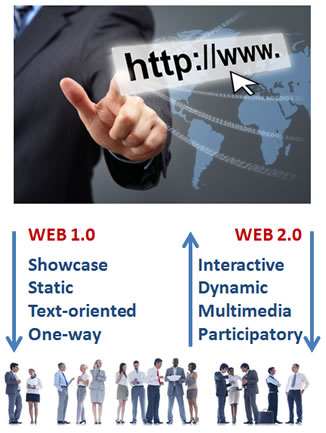
web 2.0
communication
When Web 2.0 was named this way in 2004, no one knew that a Web "1.0" had preceded it. Web 1.0 existed because Web 2.0 was born. As a matter of fact, to speak of Web 2.0 was solely a marketing ploy born of traditional software naming practices where successive versions were referenced as 1.0, 2.0 and their intermediate evolutions specified as 1.1, 1.2, and so on.
Web 1.0 reproduced the classical model of the relationship between brands and/or companies and their customers, with the vendor located on one side and the consumer on the other. The vendor spoke; the customers listened. The company wrote a message and dispatched it to the public (press release, marketing literature, outdoor billboard display, catalogue, mailing, advertisement…)
From Web 1.0 to Web 2.0 – From information to communication
With Web 2.0, the business of "communication" at last deserved its name! Until recently it was a business dedicated to "information". Communication is only effective if it is bilateral, a two-way process. Sending messages to prospects is not communication with potential customers. Publishing a newspaper is not communication with potential readers.
Even better: in today’s world, not only do companies dialogue with their publics — their publics dialogue with each other, via blog comments and through various social networks.
And all of this happens around the clock, 24/7, at the speed of the Internet, on huge volumes of data.
The days are long gone when a company facing a crisis communication situation could afford to spend several days preparing its response to consumers. On the Internet, the wildfire effect is the buzz: it spreadsat the speed oflight. And be careful, a negative buzz is a rumor. A rumor rarely circulates good news.
Our Web 2.0 communications tools at your disposal
Social networks and community management
 A company can stay away from social networks and survive. A company may decide to have its own Facebook page just to avoid having to explain why it is not there. There is however a third approach, the one that we recommend, that consists of engaging in social networks with a true strategy and adapted means. We have a successful track record of operations on Facebook as well as other social media for the benefit of our clients.
A company can stay away from social networks and survive. A company may decide to have its own Facebook page just to avoid having to explain why it is not there. There is however a third approach, the one that we recommend, that consists of engaging in social networks with a true strategy and adapted means. We have a successful track record of operations on Facebook as well as other social media for the benefit of our clients.
"Community Manager" is a brand new profession: there were no previous training courses, no school to become a community manager etc. until 2011. The mission of a community manager is to facilitate the discussions and unite communities on the Internet on behalf of a company or brand. Tightly associated with Web 2.0 and social networks, the profession of community manager is rapidly evolving. The heart of the job lies in the interaction and exchange with netizens (moderate, facilitate).
According to French employment organizations Apec and Pôle Emploi, candidates who most suited for this new profession come from journalism and Press Relations

Community manager, requested capabilities:
• Extensive availability (be in watching mode)
• Be responsive
• Diplomacy and listening skills
• Be knowledgeable on client products
• Inquisitiveness
• Be fluent in English
• Advanced writing skills
Blogs

It seems that blogs have been with us for a long time. In reality, blogs started to spread around 2002-2003. It is said that 3 million blogs are born every day in the world and there are nearly 200 million blogs. This is an impressive number, however we must immediately point out that a lot of blogs are abandoned. Opening a blog is a simple procedure while making it alive and up to date is a daunting task.
We managed and fed multiple blogs for our clients, providing them with relevant content, applying the tight frequency that is necessary to make visitors come back.
Production of editorial content
 The term "content" is inherited from the computer industry. The Press speaks of articles or stories, readers, circulation, number of copies sold. The web speaks of content, visitors, clicks, traffic generation. Editorial content is the basic food of everything that is published on the web. Editorial content is required by any web site or blog willing to attract and retain visitors. This occurs with a greater sharpness than for conventional media that have calibrated paging and fixed periodicity. Once on the web, media enters another dimension: it is no longer a daily, weekly or monthly publication; at every moment of the day it is obliged to integrate the incoming news and feed its visitors with fresh content in streaming mode. Hence an unquenchable thirst for content.
The term "content" is inherited from the computer industry. The Press speaks of articles or stories, readers, circulation, number of copies sold. The web speaks of content, visitors, clicks, traffic generation. Editorial content is the basic food of everything that is published on the web. Editorial content is required by any web site or blog willing to attract and retain visitors. This occurs with a greater sharpness than for conventional media that have calibrated paging and fixed periodicity. Once on the web, media enters another dimension: it is no longer a daily, weekly or monthly publication; at every moment of the day it is obliged to integrate the incoming news and feed its visitors with fresh content in streaming mode. Hence an unquenchable thirst for content.
Video

For a small or medium size enterprise, producing a video clip was not affordable before year 2000 (and a bit after). Today a tiny budget is sufficient for shooting and editing a nice video clip… and its publication is free on the internet. For a video report, an application story, a customer testimonial, a corporate announcement (crisis, results, agreement…) you can produce a fine video for a few hundred euro.
One piece of advice. Shun—like the plague—any amateur DIY. In this area mediocrity is not forgiven: the viewer is in front of his/her computer monitor, anticipating TV-like viewing with impeccable production. The sound in particular is often the weakest link of sloppy video clips. For our video production offering we rely on the solid and proven experience of professionals from tv production companies.


